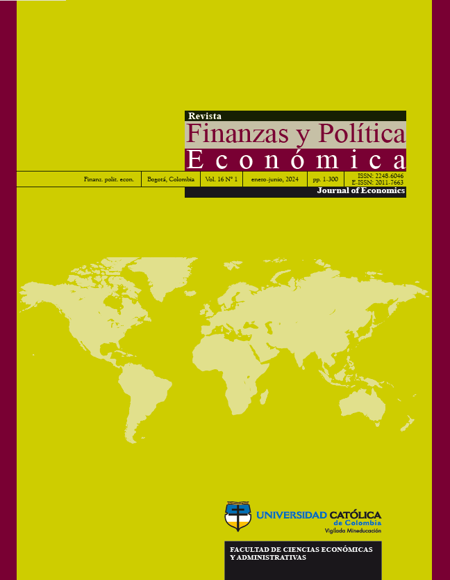
This work is licensed under a Creative Commons Attribution-NonCommercial-ShareAlike 4.0 International License.
This journal is licensed by a Creative Commons Attribution License (CC BY-NC-SA 4.0) Attribution-Non Commercial 4.0 International. For the CC licenses, the principle isthe creative freedom. This system complements the copyright without opposing it, conscious of its importance in our culture. The content of the articles is the responsibility of each author, and does not compromise in any way, to the journal or the university. It allows the transmission and reproduction of titles, abstracts and full content, with academic, scientific, cultural ends, provided acknowledgment of the respective source. This work cannot be used for commercial purposes.
They journal does not charge authors for submission or publication.
Abstract
The purpose of this work is to propose an adaptation of the Economic Value Added (EVA) methodology in order to be applied in Higher Education Institutions -IES- in Colombia, for which its calculation was carried out in ten (10) IES on the period 2019-2021. The results, once the adaptation and calculation have been carried out, show that nine of the ten HEIs analyzed in the three years studied destroy value, and to cover the high cost of operating capital obtained, they require generating between 2 and 17 times more than the equivalent of their respective operational surpluses, which leads us to reflect on the importance of beginning to propose adaptations to the calculation of financial indicators specific to the sector in order to improve financial management and have greater basis elements for making correct and timely decisions.

References
Acevedo, D., Montero, P. & Durán, M. (2016). Análisis de la productividad académica de profesores del área de Ingeniería. Formación Universitaria, 2, 89-96.
Acosta, L., Becerra, F. & Jaramillo, D. (2017). Sistema de Información Estratégica para la Gestión Universitaria en la Universidad de Otavalo (Ecuador). Formación Universitaria, 10(2), 103-112. doi:https://dx.doi.org/10.4067/S0718-50062017000200011
Calle, V., Gamboa, R. & Gómez, O. (2008). Inductores de valor para instituciones de educación superior privadas en Colombia. Universidad EAFIT.
Campos, J., Serebrisky, T. & Suárez-Alemán, A. (2015). Porque el tiempo pasa: evolución teórica y práctica en la determinación de la tasa social de descuento. Banco Interamericano de Desarrollo.
Campos, J., Serebrisky, T. & Suárez-Aleman, A. (2016). Tasa de descuento social y evaluación de proyectos. Banco Interamericano de Desarrollo.
Cartes, F., Contreras, E. & Cruz, J. M. (2007). Tasa Social de Descuento en Chile. https://goo.gl/CYuc2q
Congreso de Colombia (1992, 28 de diciembre). Ley 30 de 1992. Por la cual se organiza el servicio público de la Educación Superior.
Correa, S. (2013). Valoración de empresas en instituciones privadas de educación básica. Universidad Nacional de Colombia.
Díaz Álvarez, W. (2009). Aproximación al Valor Económico Agregado (Economic Value Added, EVA) en organizaciones públicas. Universidad y Empresa, 11(16), 215-241. https://revistas.urosario.edu.co/index.php/empresa/article/view/1078
Dunbar, K. (2013). Economic Value Added (EVA TM): A thematic bibliography. Journal of New Business Ideas & Trends, 11(1), 54-66.
Fernández, P. (2008). Métodos de valoración de empresas. Centro Internacional de Investigación Financiera.
Fernández-Baca, J. (2011). Actualización de la Tasa Social de Descuento. Ministerio de Economía y Finanzas.
García, O. (2003). Valoración de empresas, gerencia del valor y EVA. Prensa Moderna.
Lovata, L. & Costigan, M. (2002). Empirical analysis of adopters of economic value added. Management Accounting Research, 12(1), 67-78.
Machorro, F. & Romero, M. (2017). Propuesta de un Instrumento de Autoevaluación del Desempeño Organizacional en Instituciones Públicas de Educación Superior en México. Formación Universitaria, 3, 3-10.
Nava Rosillón, M. (2009). Análisis financiero: una herramienta clave para una gestión financiera eficiente. Revista Venezolana de Gerencia, 14(48), 606-628. https://ve.scielo.org/scielo.php?script=sci_arttext&pid=s1315-99842009000400009
Piraquive, G., Matamoros, M., Céspedes, E. & Rodríguez, J. (2018). Actualización de la tasa de rendimiento del capital en Colombia bajo la metodología de Harberger. Departamento Nacional de Planeación.
Rompho, N. (2009). Application of the Economic Value Added (EVA) protocol in a university setting as a capital budgeting tool. Journal of Financial Reporting & Accounting, 2, 1-17.
Sharma, A. & Kumar, S. (2010). Economic Value Added (EVA) - Literature review and relevant issues. International Journal of Economics and Finance, 2. doi:https://doi.org/10.5539/ijef.v2n2p200
Stern, J. (2001). The EVA Challenge: Implementing Value-Added Change in an Organization. John Wiley & Sons.
Stern, J., Stewart, G. B. & Chew, D. H. (1995). The Eva® Financial Management System. Journal of Applied Corporate Finance, 8(2), 32-46.
Verdezoto Reinoso, M., Guanuche, R. & Soto Gonzáles, C. (2018). Fundamentos de la gestión financiera. En M. Fajardo Ortiz & C. Soto González, Gestión Financiera Empresarial (pp. 39-62). UTMACH.
Wu, H. Y., Lin, Y. K. & Chang, C. H. (2011). Performance evaluation of extension education centers in universities based on the balanced scorecard. Evaluation and Program Planning, 34(1), 37-50.
Zuniga-Jara, S., Barraza-Carvajal, J., Sanhueza-Muñoz, N. & Soza-Amigo, S. (2018). Midiendo la creación de valor en una universidad. Formación Universitaria, 11(3), 87-96. doi:https://dx.doi.org/10.4067/S0718-50062018000300087


























